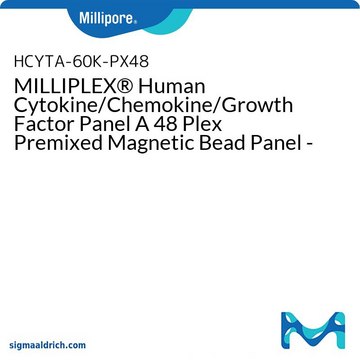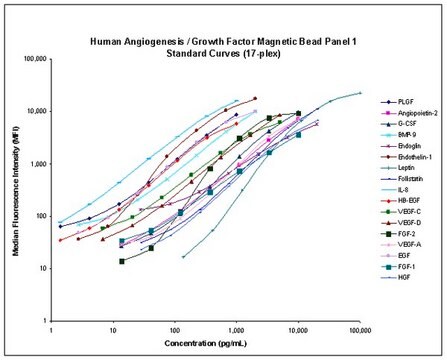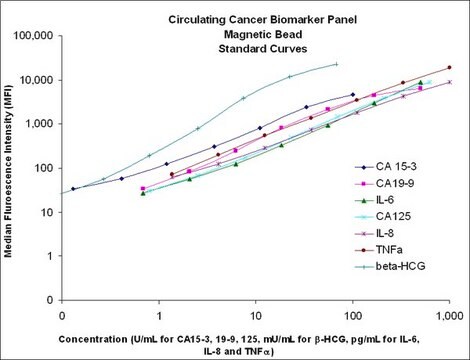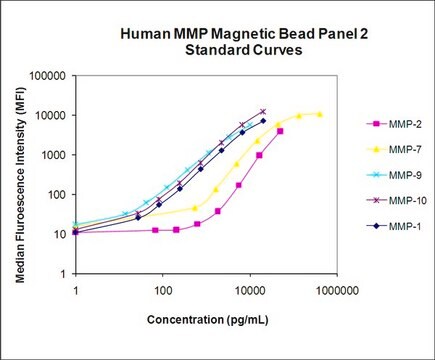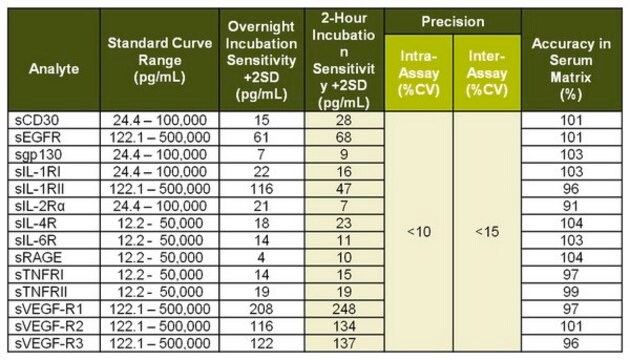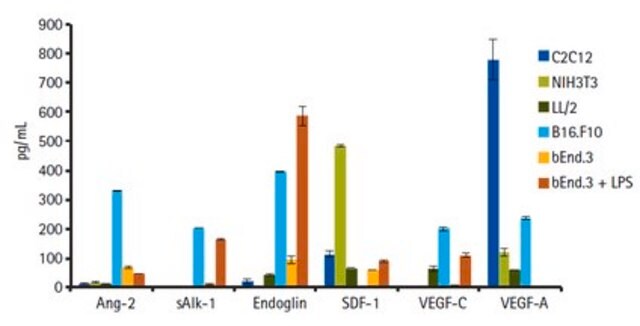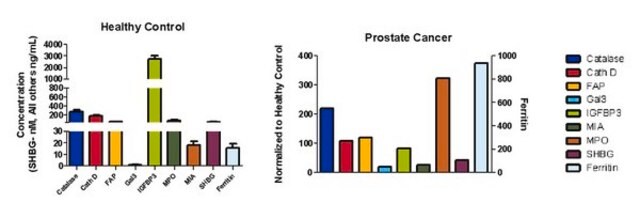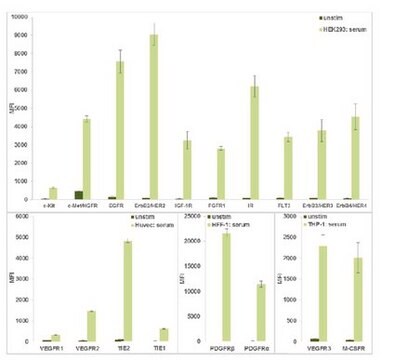HANG2MAG-12K
MILLIPLEX® Human Angiogenesis Panel 2, HANG2MAG-12K
Angiogenesis Bead-Based Multiplex Assays using the Luminex technology enables the simultaneous analysis of multiple angiogenic biomarkers in human serum, plasma and cell culture samples.
About This Item
Polecane produkty
Poziom jakości
reaktywność gatunkowa
human
producent / nazwa handlowa
Milliplex®
assay range
accuracy: 88-97%
standard curve range: 137-100,000 pg/mL
(Thrombospondin-2)
standard curve range: 137-100,000 pg/mL
(sVEGFR2)
standard curve range: 137-100,000 pg/mL
(suPAR)
standard curve range: 14-10,000 pg/mL
(sAXL)
standard curve range: 14-10,000 pg/mL
(sHER3)
standard curve range: 14-10,000 pg/mL
(sVEGFR1)
standard curve range: 27-20,000 pg/mL
(sIL-6Rα)
standard curve range: 27-20,000 pg/mL
(sPECAM-1)
standard curve range: 27-20,000 pg/mL
(sTIE-2)
standard curve range: 274-200,000 pg/mL
(Angiostatin)
standard curve range: 274-200,000 pg/mL
(sE-Selectin)
standard curve range: 274-200,000 pg/mL
(sNeuropilin-1)
standard curve range: 41-30,000 pg/mL
(Osteopontin (OPN))
standard curve range: 41-30,000 pg/mL
(sEGFR)
standard curve range: 41-30,000 pg/mL
(sHER2)
standard curve range: 41-30,000 pg/mL
(sc-Kit/sSCFR)
standard curve range: 412-300,000 pg/mL
(sVEGFR3)
standard curve range: 69-50,000 pg/mL
(sHGFR)
standard curve range: 7-5,000 pg/mL
(PDGF-AB/BB)
metody
multiplexing: suitable
metoda wykrywania
fluorometric (Luminex xMAP)
Warunki transportu
wet ice
Opis ogólny
MILLIPLEX® Human Angiogenesis Magnetic Bead Panel 2 is a 19-plex kit to be used for the simultaneous quantification of any or all of the following analytes in serum, plasma, cell culture samples, and tissue homogenates/lysates: Angiostatin, soluble E-Selectin, (sE-Selectin), Osteopontin (OPN), Platelet Derived Growth Factor-AB/BB (PDGF-AB/BB), soluble Platelet Endothelial Cell Adhesion Molecule-1 (sPECAM-1), Thrombospondin-2 (TSP-2), soluble AXL (sAXL), soluble c-Kit/Stem Cell Growth Factor Receptor (sc-Kit/SCFR), soluble Epidermal Growth Factor Receptor (sEGFR)†, soluble Human Epidermal Growth Factor Receptor 2 (sHer2), soluble Human Epidermal Growth Factor Receptor 3 (sHer3), soluble Hepatocyte Growth Factor Receptor/c-Met (sHGFR/c-Met), soluble IL-6Rα, soluble Neuropilin-1 (sNRP-1), soluble Tie-2 (sTie-2), soluble Urokinase-type Plasminogen Activator Receptor (suPAR), soluble Vascular Endothelial Growth Factor Receptor 1 (sVEGFR1), soluble Vascular Endothelial Growth Factor Receptor 2 (sVEGFR2), and soluble Vascular Endothelial Growth Factor Receptor 3 (sVEGFR3). This kit uses a 96-well format, contains a lyophilized standard cocktail, two internal assay quality controls and can measure up to 38 samples in duplicate.
†Antibody against active site results in preferential binding to unbound EGFR.
The Luminex® xMAP® platform uses a magnetic bead immunoassay format for ideal speed and sensitivity to quantitate multiple analytes simultaneously, dramatically improving productivity while conserving valuable sample volume.
Panel Type: Circulating Cancer
Zastosowanie
- Analytes: Angiostatin, soluble AXL (sAXL) , soluble c-Kit/Stem Cell Growth Factor Receptor (sc-Kit/SCFR), soluble E-Selectin (sE-Selectin), soluble Epidermal Growth Factor Receptor (sEGFR/sErbB1/sHER1)†, soluble Human Epidermal Growth Factor Receptor 2 (sHer2/sHER2/sErbB2), soluble Human Epidermal Growth Factor Receptor 3 (sHer3/ sHER3 / sErbB3), soluble Hepatocyte Growth Factor Receptor (sHGFR/c-Met/sc-Met), soluble IL-6Rα (IL-6Rα (soluble)/sIL-6Rα), soluble Neuropilin-1 (sNRP-1), Osteopontin (OPN), Platelet Derived Growth Factor-AB/BB (PDGF-AB/BB), soluble Platelet Endothelial Cell Adhesion Molecule-1 (sPECAM-1/sCD31), Thrombospondin-2 (TSP-2), soluble Tie-2 (sTie-2), soluble Urokinase-type Plasminogen Activator Receptor (suPAR), soluble Vascular Endothelial Growth Factor Receptor 1 (soluble VEGFR1, sVEGFR1/ sFlt-1), soluble Vascular Endothelial Growth Factor Receptor 2 (soluble VEGFR2/sVEGFR2/ sKDR/sFlk-1), soluble Vascular Endothelial Growth Factor Receptor 3 (soluble VEGFR3/sVEGFR3/ sFlt-4).
- †Antibody against active site results in preferential binding to unbound EGFR.
- Recommended Sample Type: Human serum, plasma, cell culture supernatants and tissue/cell homogenates/lysates
- Recommended Sample Dilution: 25 μL per well of 1:5 diluted plasma or serum; cell culture supernatant may be used undiluted or diluted with appropriate control medium
- Assay Run Time: Overnight (16-18 hours) at 2-8°C
- Research Category: Cancer
Cechy i korzyści
Inne uwagi
Informacje prawne
Hasło ostrzegawcze
Danger
Zwroty wskazujące rodzaj zagrożenia
Zwroty wskazujące środki ostrożności
Klasyfikacja zagrożeń
Acute Tox. 3 Dermal - Acute Tox. 4 Inhalation - Acute Tox. 4 Oral - Aquatic Chronic 2 - Eye Dam. 1 - Skin Sens. 1 - STOT RE 2
Organy docelowe
Respiratory Tract
Kod klasy składowania
6.1C - Combustible acute toxic Cat.3 / toxic compounds or compounds which causing chronic effects
Certyfikaty analizy (CoA)
Poszukaj Certyfikaty analizy (CoA), wpisując numer partii/serii produktów. Numery serii i partii można znaleźć na etykiecie produktu po słowach „seria” lub „partia”.
Masz już ten produkt?
Dokumenty związane z niedawno zakupionymi produktami zostały zamieszczone w Bibliotece dokumentów.
Powiązane treści
Detection of cancer biomarkers through multiplex cancer assays can accelerate studies of normal homeostasis and tumorigenic processes. See how MILLIPLEX® multiplex cancer assays are advancing various cancer research areas including lung cancer, breast cancer, and immuno-oncology research.
Wykrywanie biomarkerów nowotworowych za pomocą multipleksowych testów nowotworowych może przyspieszyć badania normalnej homeostazy i procesów nowotworowych. Zobacz, jak multipleksowe testy nowotworowe MILLIPLEX® rozwijają różne obszary badań nad rakiem, w tym raka płuc, raka piersi i badania immunoonkologiczne.
Learn how multiplexing with MILLIPLEX® multiplex assays can help simplify cancer research by measuring multiple circulating biomarkers at once. Find multiplex panels to analyze JAK-STAT, mTOR, MAPK, SAPK, TGFβ signaling pathways, and more.
Learn how immunoassays are used in cosmetics and personal care research to discover potential harmful effects of cosmetics products, and assess markers of inflammation, sensitization, aging, and tissue regeneration among others.
Nasz zespół naukowców ma doświadczenie we wszystkich obszarach badań, w tym w naukach przyrodniczych, materiałoznawstwie, syntezie chemicznej, chromatografii, analityce i wielu innych dziedzinach.
Skontaktuj się z zespołem ds. pomocy technicznej